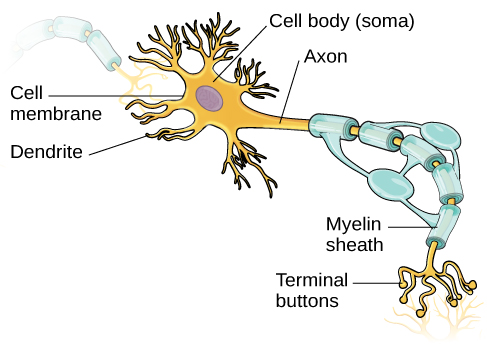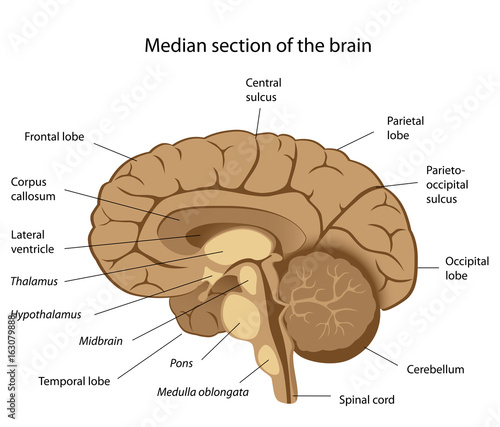UNIT 2
THE BRAIN
Neural and Hormonal SystemsNeuron
- Terminal branches of axon (from junctions with other cells)
- Axon (passes messages away from the cell body to other neurons, muscles, or glands)
- Meylin Sheath (covers the axon of some neurons and helps speed neural impulses)
- Neural Impulses (electrical signals traveling down the axon)
- Dendrites (receive messages from other cells)
- Cell Body (the cell's life support; support center)
- Neurons do NOT touch each other - the space in between

How does a Neuron fire?
It is an electrochemical process
- electrical inside the neuron
- chemical outside the neuron (in the synapse in the form of a neurotransmitter)
- the firing is called Action Potential
The All-or-None Response
- The idea that either the neural fires or it does not- no part way firing
- like a gun
Steps of Action Potential
- dendrites receive neurotransmitter from another neuron across the synapse
- reached its threshold- then fires based on the All-or-None response
- opens up a portal in axon, and lets in positive ions (sodium) which mix with negative ions (potassium) that's already inside the axon (thus neurons at rest have a slightly negative charge)
- the mixing of + and - ions causes an electrical charge that pens up the next portal (letting in more K) while closing the original portal
- process continues down the axon to the axon terminal
- terminal buttons turns electrical charge into chemical (neurotransmitters) and shoots messages to the next neuron across the synapse
Neurotransmitters
- chemical messengers released by the terminal buttons through the synapse
- Its function is motor movement and maybe memory
- If you have too much Ac H you get depression
- If you don't have enough Ac H it leads to Alzheimer's
- Its function is motor movement and alertness
- Lack of Dopamine is associated with Parkinson's disease
- Overabundance is associated with Schizophrenia
- Function deals with mood control
- Does affect hunger, sleep, and arousal
- Lack of Serotonin has been linked with depression
- Function deals with pain control
- We become addicted to endorphin causing feelings
- It's a major inhibitory neurotransmitter
- An under supply of GABA is linked to seizures, trimmers, and insomnia
- It's associated with alertness and arousal
- Under supply can depress the mood
- It's a major excitatory neurotransmitter
- It's involved in memory
- An oversupply can overstimulate the brain produce migraines or seizures
- Involved in energy and glucose metabolism
- Too much ca result in anxiety and restlessness
- Too little has been associated with depression
Nervous Systems
- Agonists - make neurons fire
- Antagonists - stop neural firing
- Reuptake Inhibitors - block neurotransmitters from entering the neuron
Divisions
Central Nervous System
- The brain and spinal cord
- CNS
- All nerves that are encased in bone
- Everything but the spinal cord and brain
- Divided into 2 categories... Somatic and Autonomic
- controls voluntary muscle movement
- uses motor (efferent) neurons
- controls the automatic functions of the body
- divided into 2 categories... the Sympathetic and Parasympathetic
- fight or flight response
- automatically accelerates heart rate, breathing, dilates pupils, slows down digestion
- automatically slows down body after a successful event
- Heart rate and breathing slows down, pupils constrict, and digestion speeds up
- a system of glands that secrete hormones
- similar to nervous system, except hormones work a lot slower than neurotransmitters
Ways to Study the Brain
Accidents
- Phineas Gage story
- personality changed after the accident
Lesions
- Removal destructions of some part of the brain
Electroencephalogram (EEG)
- detects brain waves through their electrical output
- used mainly in sleep research
Computerized Axial Tomography (CAT Scan)
- 3-D Xray of the brain
- Good for locating tumors, but tells us nothing about function
Magnetic Resonance Imaging (MRI)
- More detailed picture of brain using magnetic field to knock electrons off axis
- Takes many still pictures and turns images into a movie like production
Positron Emission Tomography (PET Scan)
- Measures how much of a chemical the brain is using (usually glucose consumption)
Functional MRI
- Combination of PET and MRI
Parts of the Brain
Hind-brain
- controls basic biological structures
Medulla
- part of the hind
- located just above the spinal cord
- involved in the control of breathing, heart rate, and blood pressure
- located just above the medulla
- it connects the hind-brain, mid-brain, and fore-brain
- involved with facial expressions and deals with emotions
- bottom rear of the brain
- known as the little brain
- coordinates fine muscle movement
Mid-Brain
- coordinates simple movement with sensory information
- the most important structure in the mid-brain is know as reticular formation
- Reticular Formation- controls arousal and ability to focus our attention
Fore-Brain
- what makes us human
- largest part of the brain
- made up of thalamus, lymbic system, and cerebral cortex
Thalamus
- switch board of brain
- receives sensory signals from the spinal cord and sends them to other parts of the fore-brain
- every sense except smell
Lymbic System
- Hypothalamus
- may be the most important structure of the brain
- controls and regulates body temperature, sexual arousal, hunger, thirst, and the endocrine system
- Hippocampus
- involved in the processing and storage of memories
- Amygdala
- secretes hormones to your bloodstream
Cerebral Cortex
- made up of packed neurons we call "gray matter"
- Glial Cells- support brain cells
- wrinkles are called fissures
Corpus Callosum
- thick bundle of nerves
- divides the two hemispheres
Hemispheres
- brain divided into two hemispheres
- contralateral control- right controls the left and vice versa
- Left Hemisphere: logic and sequential tasks
- Right Hemisphere: Spacial and creative tasks
Brain Plasticity
- the idea that the brain, when damaged, will attempt to find new ways to reroute messages
- Children's brains are more plastic than adults
Four Frontal Lobes
Frontal Lobe
- Thought and emotional control
- Contains Motor Cortex: sends signals to the body to control muscle movemet
- Contains Borca's Area: responsible for controlling muscles and produce speech
- Damage to Borca's Area is called Borca's Aphasia: unable to make movement to talk
Parietal Lobe

- Contains the Sensory Cortex: receives incoming touch sensations from the rest of the body
- Association Areas: any area not associated with receiving sensory information or coordinating muscle movement
Occipital Lobe
- deals with vision
- Contains Visual Cortex: interprets messages from our eyes into images we understand
Temporal Lobe
- deals with hearing
- process sound sensed by our ears
- interpreted in auditory cortex
- not laterized
- Contains Wernike's Area: interprets written and spoken speech
- Wernike's Aphasia: unable to understand language- the syntax and grammar jumbled

I love the organization of your blog context wise, the overall categories flow well for someone learning about each of these topics, the only qualm I have which is probably a personal thing, is the organization of the neuron because it's a bit random, but that's more of a me thing.
ReplyDelete